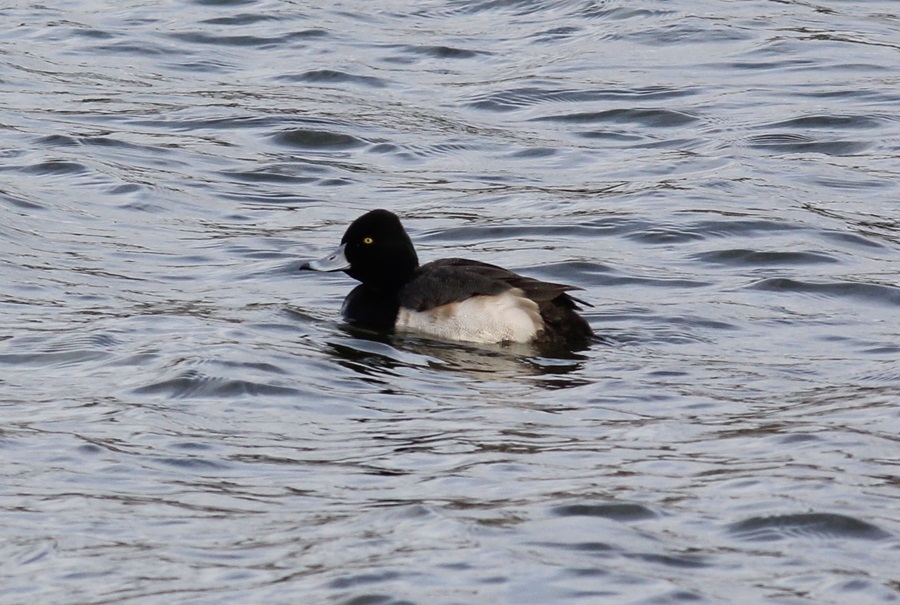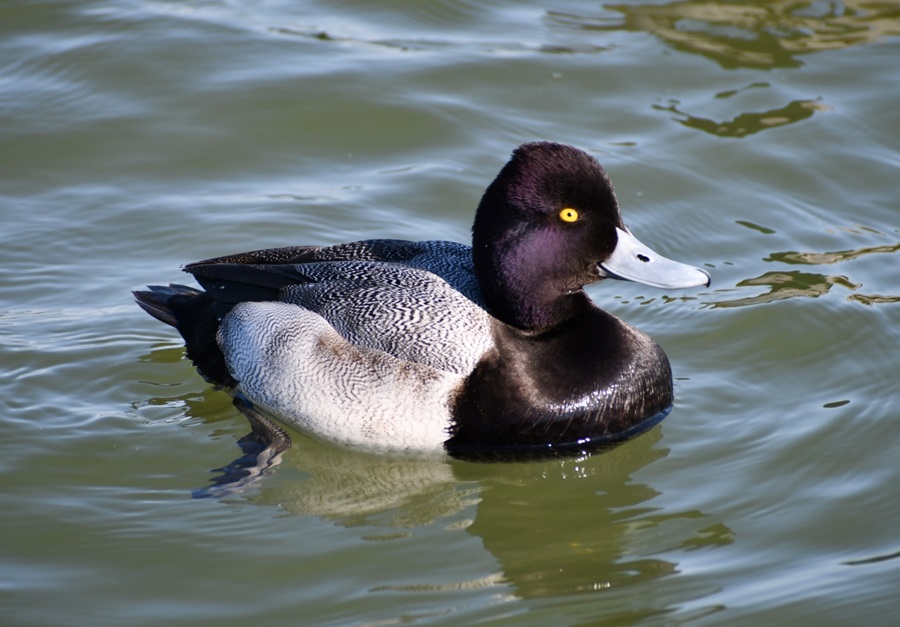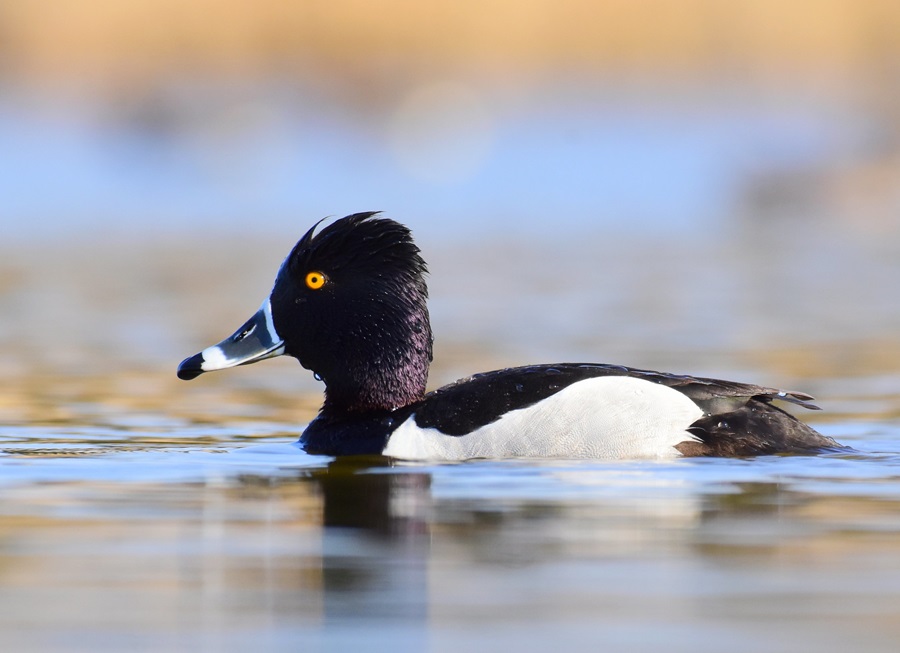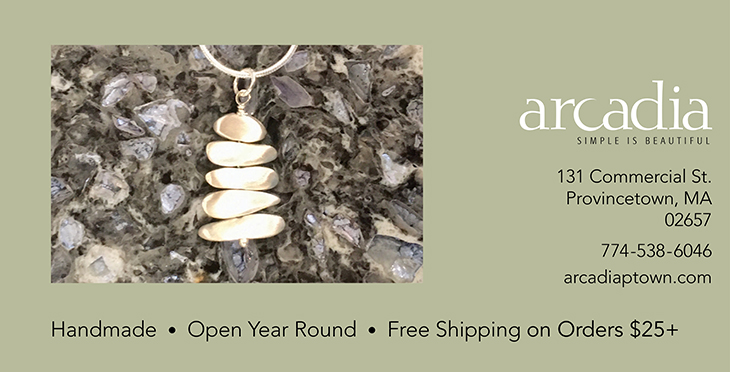What do you do when you see a bird that looks like no bird you’ve seen before — not even in photos or illustrations or anywhere?
A few days after New Year’s, I was birding on the Wellfleet town pier. It’s a fun, easy place to bird — the pier juts out into deeper water where ducks gather in the winter, so it’s a good place to watch them up close. On that morning, there was a flock of scaup off the end of the pier — diving ducks with black heads and breasts, white sides, and black tails.
Well, they were mostly scaup. Because among this flock there was one duck that looked strange. It resembled the others, but its back was black when it should have been gray, and its blue bill had a white ring around the black tip. These features made it look more like the closely related ring-necked duck. But that species has a white spur on its flank and a white rim around the bill’s base, so it didn’t quite match that either. Really, this bird seemed to exist halfway between these two species.

I took some photos and sent them off to a few friends. They backed up my suspicions: this appeared to be neither a scaup nor a ring-necked duck but rather a hybrid scaup x ring-necked duck. Its parents were members of two different species.
If you took high school biology, you are probably familiar with the traditional definition of species: any group of animals that can interbreed and produce healthy offspring. But that definition is oversimplified, and perhaps its biggest flaw is that different species create healthy offspring all the time — it’s called hybridization. A 2019 review published in Nature found that as many as 10 percent of animals can likely hybridize with a close relative.
Birds are no exception. Hybrid birds are generally rare, but with patience, a careful eye, and a healthy dose of luck, it is possible to find hybrids just about anywhere, including here on Cape Cod.
Hybrids are more frequent among some types of birds than others. Perhaps the most prolific hybridizers are gulls. The typical “seagulls” have pretty much all interbred with each other, creating hybrids with some fantastic colloquial names among birders. Herring gulls that breed with great black-backed gulls produce “Great Lakes” gulls, while herring gulls and lesser black-backed gulls produce “Appledore” gulls, named after the island in Maine where the two readily interbreed. Great black-backed gulls and glaucous gulls, meanwhile, produce “Viking” gulls.
Gull hybrids, however, are extremely difficult to identify. Traits like the extent of black on a specific wing feather or the exact shade of grayish brown on the tail can be the key to identifying these birds. They usually require detailed photographs to identify correctly. I don’t have the kind of patience required to sort them out.

Waterfowl, meanwhile, are also regular hybridizers and are simpler to identify. The most prolifically hybridizing waterfowl are mallards. Wherever they are, they will try hybridizing with just about everything. On Cape Cod, this means they will hybridize with the closely related American black ducks.
A male mallard-black duck hybrid sports a darker body like an American black duck but with a big splotch of green on the side of the head and curly tail feathers, betraying its mallard heritage. These hybrids are uncommon but appear with some regularity.
The frequency with which these birds hybridize, however, can lead to serious problems. There are far more mallards than American black ducks in North America, and a 2019 study led by University of Texas researchers found that hybrids of the two prefer to breed with mallards, whose offspring then breed with more mallards. In this way, the hybridizing slowly siphons black duck genes away from the population, reducing its numbers.
University of Maine Professor Emerita Judith Rhymer argued in a 2006 paper that hybridization among waterfowl can ultimately lead to the extinction of some species — though black ducks are nowhere near that level of risk, for now.
But as quickly as hybridization can drive species to extinction, it can create them, too.

One of the most surprising developments in recent years has been the discovery of hybrid speciation. This is when two species hybridize so much that their hybrids become a population all on its own, interbreeding primarily with like hybrids, and then evolving independently of either parent species. The sleek seabird known as the pomarine jaeger, for instance, which sometimes graces Cape Cod beaches in the fall, may have evolved from a population of hybrids between two other seabirds known as parasitic jaeger and great skua, according to recent genetic research.
None of the common Cape Cod birds are the result of this process. But some biologists argue that eastern coyotes, which formed as hybrids between wolves, coyotes, and domestic dogs in the 1920s, might be on their way to becoming a new species. That should be settled within a few thousand years of evolution.
Individual hybrids can sometimes become “celebrities” in the birding world. For the last two years, a hybrid goose that is a mixture of the all-white snow goose and the smaller dark goose known as the brant has spent the winter at Fort Phoenix in New Bedford. This bird, affectionately termed the “snant” or the “bro” goose, is small and dark-bodied but with an all-white neck and hangs out in a big flock of brant. I know birders who have made the trip out to New Bedford just to see this rare hybrid.
“Bro” geese are extremely rare, so this individual doesn’t likely represent the beginning of a new species nor the start of an extinction-by-hybridization. It is, however, an example of how easily the natural world can challenge our assumptions.
Hybrids show us how nebulous our conception of a “species” really is. We try to put the natural world into boxes, but nature defies our attempts to organize it. Finding that hybrid duck in Wellfleet was a surprise to me but no big deal to the bird — it didn’t care that its parents are of two different species.
Maybe we will never get a perfect definition of a species, but we get a whole slate of remarkable bird combinations instead.



